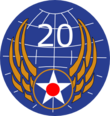
Operation Matterhorn was a military operation of the United States Army Air Forces in World War II for the strategic bombing of Japanese forces by B-29 Superfortresses based in India and China. Targets included Japan itself, and Japanese bases in China and South East Asia. The name comes from the Matterhorn, a mountain traditionally considered particularly difficult to climb.

The XX Bomber Command was a United States Army Air Forces bomber formation. Its last assignment was with Twentieth Air Force, based on Okinawa. It was inactivated on 16 July 1945.

The Twentieth Air Force (Air Forces Strategic) (20th AF) is a numbered air force of the United States Air Force Global Strike Command (AFGSC). It is headquartered at Francis E. Warren Air Force Base, Wyoming.

Frank Alton Armstrong Jr. was a lieutenant general of the United States Air Force. As a brigadier general in the United States Army Air Forces during World War II, he was the inspiration for the main character in the novel and subsequent film, Twelve O'Clock High. After the war, he held a variety of senior leadership positions prior to and following the establishment of the USAF as an independent service in 1947. Promoted to major general in 1950, he advanced to lieutenant general in 1956 and retired at that rank in 1961.
Brigadier General Clifford Schoeffler was director of operations and training in the Office of the Deputy Chief of Staff, Operations, Headquarters Strategic Air Command, Offutt Air Force Base, Nebraska. He was a command pilot with more than 10,000 flying hours accumulated during his career.

Lieutenant General Robert Hamilton Warren was a U.S. Air Force General and was the fourth Superintendent of the United States Air Force Academy.
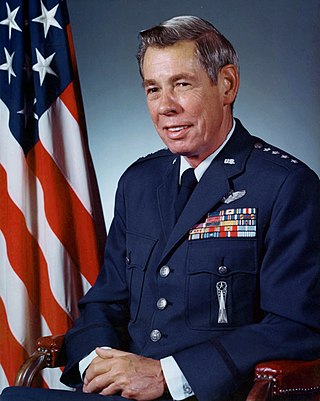
Richard Hastings Ellis was a United States Air Force general who served as the commander in chief of the Strategic Air Command and director of the Joint Strategic Target Planning Staff with headquarters at Offutt Air Force Base, Nebraska. He was also director of the Joint Strategic Connectivity Staff.

Francis Walter Nye was a United States Air Force major general who was a B-24 Liberator and B-29 Superfortress combat pilot. He was commander, Field Command, Defense Atomic Support Agency, Sandia Base, New Mexico.

General James Arthur Hill was a four-star general in the United States Air Force (USAF) who served as Vice Chief of Staff of the United States Air Force.

General Jack Joseph Catton was a United States Air Force four-star general and was commander of the Air Force Logistics Command with headquarters at Wright-Patterson Air Force Base and of the Military Airlift Command.

General Emmett E. "Rosie" O'Donnell Jr. was a United States Air Force four-star general who served as Commander in Chief, Pacific Air Forces (CINCPACAF) from 1959 to 1963. He also led the first B-29 Superfortress attack against Tokyo during World War II.

Joseph Randall Holzapple was a United States Air Force four-star general who served as Commander in Chief, U.S. Air Forces in Europe (CINCUSAFE) from 1969 to 1971.

Brigadier General Robert Falligant Travis was a United States Army Air Forces general during World War II.
Leslie J. Westberg was a brigadier general in the United States Air Force. He piloted bombers on combat missions in both World War II and the Korean War and reconnaissance aircraft in the Vietnam War.

General Maurice Arthur Preston was a United States Air Force four-star general who served as Commander in Chief, United States Air Forces in Europe (CINCUSAFE) from 1966 to 1968.
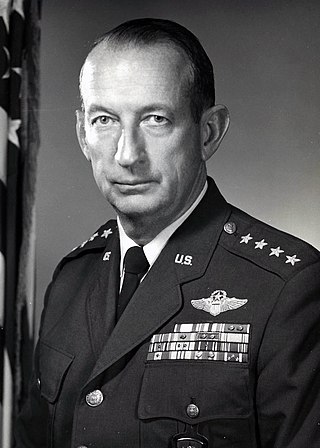
Horace Milton Wade was a former general in the United States Air Force and a former Vice Chief of Staff of the United States Air Force.

Earl Terrence O'Loughlin is a former general and commander of the Air Force Logistics Command, with headquarters at Wright-Patterson Air Force Base, Ohio.
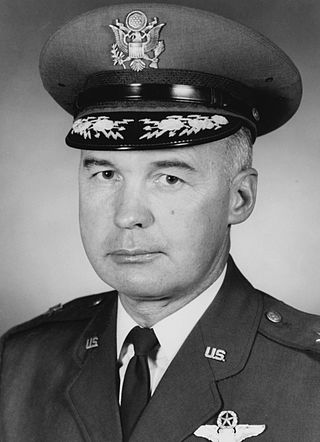
Lieutenant General George H. McKee was an American Air Force lieutenant general and command pilot who was commander of Air Training Command with headquarters at Randolph Air Force Base, Texas.
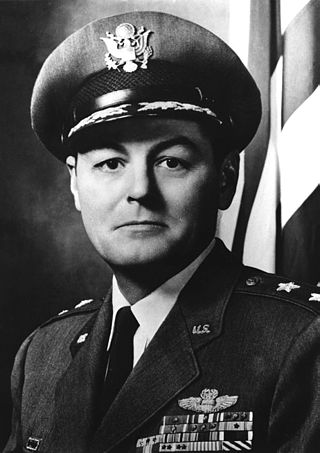
Richard Henry Carmichael was a flag officer in the United States Air Force and a highly decorated bomber pilot. He twice received the Distinguished Service Cross. Carmichael piloted the first B-29 Superfortress to be shot down over Japan in World War II, while leading the 462d Bombardment Group in the bombing of Yawata on 20 August 1944, the first daylight air raid on Japan since the Doolittle Raid in 1942. He remained a prisoner of war until he was liberated on 29 August 1945. During the Korean War, he flew another 39 combat missions as commander of the 98th Bombardment Group. He was commandant of the Air Command and Staff College, before he retired from the Air Force on 19 January 1961.

John Landrum Martin Jr. was a major general in the United States Air Force. He enlisted in the United States Army Air Corps in 1940 and flew combat missions in Boeing B-29 Superfortress bombers in the China-Burma-India Theater.



